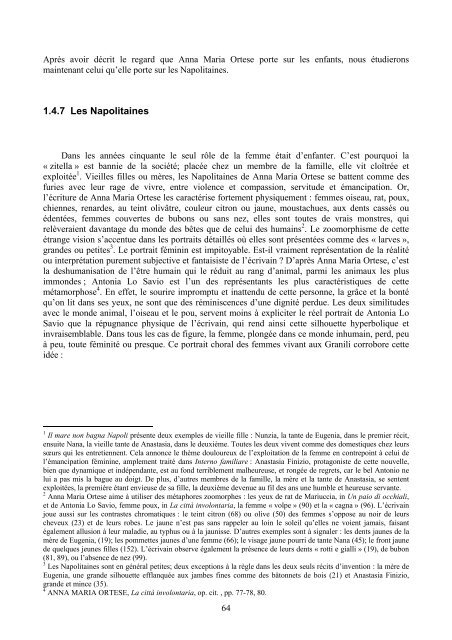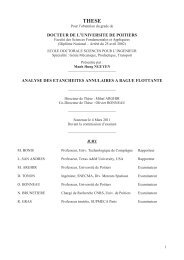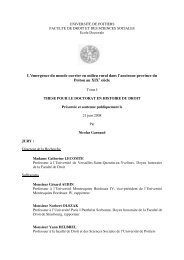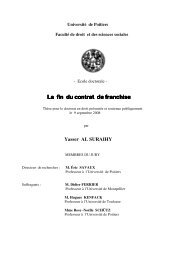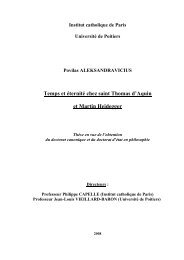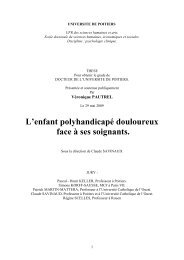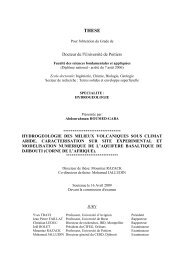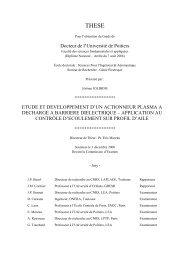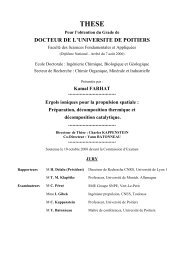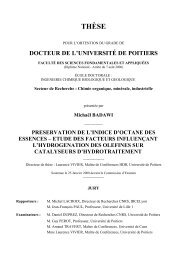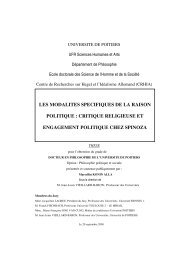Consulter le texte intégral de la thèse - Université de Poitiers
Consulter le texte intégral de la thèse - Université de Poitiers
Consulter le texte intégral de la thèse - Université de Poitiers
Create successful ePaper yourself
Turn your PDF publications into a flip-book with our unique Google optimized e-Paper software.
Après avoir décrit <strong>le</strong> regard que Anna Maria Ortese porte sur <strong>le</strong>s enfants, nous étudierons<br />
maintenant celui qu’el<strong>le</strong> porte sur <strong>le</strong>s Napolitaines.<br />
1.4.7 Les Napolitaines<br />
Dans <strong>le</strong>s années cinquante <strong>le</strong> seul rô<strong>le</strong> <strong>de</strong> <strong>la</strong> femme était d’enfanter. C’est pourquoi <strong>la</strong><br />
« zitel<strong>la</strong> » est bannie <strong>de</strong> <strong>la</strong> société; p<strong>la</strong>cée chez un membre <strong>de</strong> <strong>la</strong> famil<strong>le</strong>, el<strong>le</strong> vit cloîtrée et<br />
exploitée 1 . Vieil<strong>le</strong>s fil<strong>le</strong>s ou mères, <strong>le</strong>s Napolitaines <strong>de</strong> Anna Maria Ortese se battent comme <strong>de</strong>s<br />
furies avec <strong>le</strong>ur rage <strong>de</strong> vivre, entre vio<strong>le</strong>nce et compassion, servitu<strong>de</strong> et émancipation. Or,<br />
l’écriture <strong>de</strong> Anna Maria Ortese <strong>le</strong>s caractérise fortement physiquement : femmes oiseau, rat, poux,<br />
chiennes, renar<strong>de</strong>s, au teint olivâtre, cou<strong>le</strong>ur citron ou jaune, moustachues, aux <strong>de</strong>nts cassés ou<br />
é<strong>de</strong>ntées, femmes couvertes <strong>de</strong> bubons ou sans nez, el<strong>le</strong>s sont toutes <strong>de</strong> vrais monstres, qui<br />
relèveraient davantage du mon<strong>de</strong> <strong>de</strong>s bêtes que <strong>de</strong> celui <strong>de</strong>s humains 2 . Le zoomorphisme <strong>de</strong> cette<br />
étrange vision s’accentue dans <strong>le</strong>s portraits détaillés où el<strong>le</strong>s sont présentées comme <strong>de</strong>s « <strong>la</strong>rves »,<br />
gran<strong>de</strong>s ou petites 3 . Le portrait féminin est impitoyab<strong>le</strong>. Est-il vraiment représentation <strong>de</strong> <strong>la</strong> réalité<br />
ou interprétation purement subjective et fantaisiste <strong>de</strong> l’écrivain ? D’après Anna Maria Ortese, c’est<br />
<strong>la</strong> <strong>de</strong>shumanisation <strong>de</strong> l’être humain qui <strong>le</strong> réduit au rang d’animal, parmi <strong>le</strong>s animaux <strong>le</strong>s plus<br />
immon<strong>de</strong>s ; Antonia Lo Savio est l’un <strong>de</strong>s représentants <strong>le</strong>s plus caractéristiques <strong>de</strong> cette<br />
métamorphose 4 . En effet, <strong>le</strong> sourire impromptu et inattendu <strong>de</strong> cette personne, <strong>la</strong> grâce et <strong>la</strong> bonté<br />
qu’on lit dans ses yeux, ne sont que <strong>de</strong>s réminiscences d’une dignité perdue. Les <strong>de</strong>ux similitu<strong>de</strong>s<br />
avec <strong>le</strong> mon<strong>de</strong> animal, l’oiseau et <strong>le</strong> pou, servent moins à expliciter <strong>le</strong> réel portrait <strong>de</strong> Antonia Lo<br />
Savio que <strong>la</strong> répugnance physique <strong>de</strong> l’écrivain, qui rend ainsi cette silhouette hyperbolique et<br />
invraisemb<strong>la</strong>b<strong>le</strong>. Dans tous <strong>le</strong>s cas <strong>de</strong> figure, <strong>la</strong> femme, plongée dans ce mon<strong>de</strong> inhumain, perd, peu<br />
à peu, toute féminité ou presque. Ce portrait choral <strong>de</strong>s femmes vivant aux Granili corrobore cette<br />
idée :<br />
1 Il mare non bagna Napoli présente <strong>de</strong>ux exemp<strong>le</strong>s <strong>de</strong> vieil<strong>le</strong> fil<strong>le</strong> : Nunzia, <strong>la</strong> tante <strong>de</strong> Eugenia, dans <strong>le</strong> premier récit,<br />
ensuite Nana, <strong>la</strong> vieil<strong>le</strong> tante <strong>de</strong> Anastasia, dans <strong>le</strong> <strong>de</strong>uxième. Toutes <strong>le</strong>s <strong>de</strong>ux vivent comme <strong>de</strong>s domestiques chez <strong>le</strong>urs<br />
sœurs qui <strong>le</strong>s entretiennent. Ce<strong>la</strong> annonce <strong>le</strong> thème douloureux <strong>de</strong> l’exploitation <strong>de</strong> <strong>la</strong> femme en contrepoint à celui <strong>de</strong><br />
l’émancipation féminine, amp<strong>le</strong>ment traité dans Interno familiare : Anastasia Finizio, protagoniste <strong>de</strong> cette nouvel<strong>le</strong>,<br />
bien que dynamique et indépendante, est au fond terrib<strong>le</strong>ment malheureuse, et rongée <strong>de</strong> regrets, car <strong>le</strong> bel Antonio ne<br />
lui a pas mis <strong>la</strong> bague au doigt. De plus, d’autres membres <strong>de</strong> <strong>la</strong> famil<strong>le</strong>, <strong>la</strong> mère et <strong>la</strong> tante <strong>de</strong> Anastasia, se sentent<br />
exploitées, <strong>la</strong> première étant envieuse <strong>de</strong> sa fil<strong>le</strong>, <strong>la</strong> <strong>de</strong>uxième <strong>de</strong>venue au fil <strong>de</strong>s ans une humb<strong>le</strong> et heureuse servante.<br />
2 Anna Maria Ortese aime à utiliser <strong>de</strong>s métaphores zoomorphes : <strong>le</strong>s yeux <strong>de</strong> rat <strong>de</strong> Mariuccia, in Un paio di occhiali,<br />
et <strong>de</strong> Antonia Lo Savio, femme poux, in La città involontaria, <strong>la</strong> femme « volpe » (90) et <strong>la</strong> « cagna » (96). L’écrivain<br />
joue aussi sur <strong>le</strong>s contrastes chromatiques : <strong>le</strong> teint citron (68) ou olive (50) <strong>de</strong>s femmes s’oppose au noir <strong>de</strong> <strong>le</strong>urs<br />
cheveux (23) et <strong>de</strong> <strong>le</strong>urs robes. Le jaune n’est pas sans rappe<strong>le</strong>r au loin <strong>le</strong> so<strong>le</strong>il qu’el<strong>le</strong>s ne voient jamais, faisant<br />
éga<strong>le</strong>ment allusion à <strong>le</strong>ur ma<strong>la</strong>die, au typhus ou à <strong>la</strong> jaunisse. D’autres exemp<strong>le</strong>s sont à signa<strong>le</strong>r : <strong>le</strong>s <strong>de</strong>nts jaunes <strong>de</strong> <strong>la</strong><br />
mère <strong>de</strong> Eugenia, (19); <strong>le</strong>s pommettes jaunes d’une femme (66); <strong>le</strong> visage jaune pourri <strong>de</strong> tante Nana (45); <strong>le</strong> front jaune<br />
<strong>de</strong> quelques jeunes fil<strong>le</strong>s (152). L’écrivain observe éga<strong>le</strong>ment <strong>la</strong> présence <strong>de</strong> <strong>le</strong>urs <strong>de</strong>nts « rotti e gialli » (19), <strong>de</strong> bubon<br />
(81, 89), ou l’absence <strong>de</strong> nez (99).<br />
3 Les Napolitaines sont en général petites; <strong>de</strong>ux exceptions à <strong>la</strong> règ<strong>le</strong> dans <strong>le</strong>s <strong>de</strong>ux seuls récits d’invention : <strong>la</strong> mère <strong>de</strong><br />
Eugenia, une gran<strong>de</strong> silhouette eff<strong>la</strong>nquée aux jambes fines comme <strong>de</strong>s bâtonnets <strong>de</strong> bois (21) et Anastasia Finizio,<br />
gran<strong>de</strong> et mince (35).<br />
4 ANNA MARIA ORTESE, La città involontaria, op. cit. , pp. 77-78, 80.<br />
64


